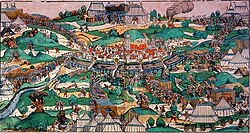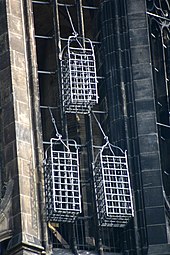Münster rebellion
This article includes a list of general references, but it lacks sufficient corresponding inline citations. (June 2020) |
Anabaptist Dominion of Münster Täuferreich von Münster | |||||||||
|---|---|---|---|---|---|---|---|---|---|
| 1534–1535 | |||||||||
 The city of Münster under siege by prince bishop Franz von Waldeck in 1534. The picture shows the first attack at Pentecost. | |||||||||
| Capital | Münster | ||||||||
| Religion | Anabaptism | ||||||||
| Government | Communal theocratic monarchy | ||||||||
| King | |||||||||
• 1534-1535 | John of Leiden | ||||||||
| Historical era | Protestant Reformation | ||||||||
• Established | February 1534 | ||||||||
• Disestablished | 24 June 1535 | ||||||||
| |||||||||
| Today part of | Münster, North Rhine-Westphalia, Germany | ||||||||

The Münster rebellion (
The city was under Anabaptist rule from February 1534, when the city hall was seized and
Rebellion

After the
With so many Anabaptist adherents in the town, Rothmann and his allies had little difficulty obtaining possession of it at the elections for the magistracy and placing Bernhard Knipperdolling as the mayor, after deposing the mainly Lutheran magistrates, who, until then, had seen him as an ally in their own distrust of, and dislike for, Catholics. Matthys was a follower of
Siege
The city was besieged by
The 25-year-old John of Leiden was subsequently recognized as Matthys' religious and political successor, justifying his authority and actions by claiming visions from heaven. His authority grew until eventually he proclaimed himself the successor of David and adopted royal regalia, honors, and absolute power in the new "Zion". There were now in the town at least three times as many women of marriageable age as men, so he made polygamy compulsory,[3] and he himself took sixteen wives. (John is said to have beheaded Elisabeth Wandscherer in the marketplace for refusing to marry him, though this act might have been falsely attributed to him after his death.) Meanwhile, most of the residents of Münster were starving as a result of the year-long siege.
After lengthy resistance, the city was taken by the besiegers on June 24, 1535, and John of Leiden and several other prominent Anabaptist leaders were captured and imprisoned. In January 1536, John of Leiden, Bernhard Knipperdolling and one more prominent follower, Bernhard Krechting, were tortured and executed in the marketplace of Münster. Their bodies were exhibited in cages which hung from the steeple of St. Lambert's Church. The bones were removed later, but the cages hang there still.
Aftermath

The Münster Rebellion was a turning point for the Anabaptist movement. It never again had the opportunity of assuming political importance, as both Catholic and Lutheran civil powers adopted stringent measures to counter this. It is difficult to trace the subsequent history of the group as a religious body, through changes in the names used and beliefs held.
The Batenburgers under Jan van Batenburg preserved the violent millennialist stream of Anabaptism seen at Münster. They were polygamous and believed force was justified against anyone not in their sect. Their movement went underground after the suppression of the Münster Rebellion, with members posing as Catholics or Lutherans as necessary. Some nonresistant Anabaptists found leaders in Menno Simons and the brothers Obbe and Dirk Philips, Dutch Anabaptist leaders who repudiated the distinctive doctrines of the Münster Anabaptists. This group eventually became known as the Mennonites after Simons. They rejected any use of violence and preached a faith based on compassion and love of enemy.
In August 1536, the leaders of Anabaptist groups influenced by Melchior Hoffman met in Bocholt in an attempt to maintain unity. The meeting included followers of Batenburg, survivors of Münster, David Joris and his sympathisers, and the nonresistant Anabaptists.[4] At this meeting, the major areas of dispute between the sects were polygamous marriage and the use of force against non-believers. Joris proposed compromise by declaring the time had not yet come to fight against the authorities, and that it would be unwise to kill any non-Anabaptists. The gathered Anabaptists agreed to the compromise of no more force,[5] but the meeting did not prevent the fragmentation of Anabaptism.
Works of fiction

- A Tale of a Tub, In the allegory of Jonathan Swift's first major work, brother "Jack" is based on "Jack of Leyden"
- Le prophète, an 1849 opera by Giacomo Meyerbeer that highly fictionalizes the rebellion
- ISBN 0-15-101063-3.
- Speak to Her Kindly: A Novel of the Anabaptists, by Jonathan Rainbow, ISBN 1-57921-590-4
- Toelle, Tom Toelle (1993). König der letzten Tage (King of the last days) (TV-series). Germany: unknown. – German historical mini-series that portrays the events of the Münster Rebellion.
- The Unfortunate Traveller by Thomas Nashe describes the events of the rebellion
- The Abyss "L'Œuvre au noir", by Marguerite Yourcenar
- The Garden of Earthly Delights by Nicholas Salaman
- The Friends of God, by Peter Vansittart
- Perfection, by Anita Mason
- Rules For a Film about Anabaptists,[6] film by Georg Brintrup,[7] Germany 1975/76
- Die Wiedertäufer, a play by Friedrich Dürrenmatt, translated by Lauren Friesen as The Anabaptists (unpublished MSS in various libraries, including the Graduate Theological Union).
- Orfeo, a novel by Richard Powers, whose main character composes an opera retelling the story
- In Nomine Dei, a play by José Saramago
- Divara – Wasser und Blut (Divara, Water and Blood), a German-language opera by Azio Corghi to a libretto by the composer after the play by Saramago
- The Golden City, a 1974 immersive drama written and performed by Strathclyde Theatre Group in Glasgow Cathedral and St Mary's Cathedral, Edinburgh (Episcopal) during the Edinburgh Festival Fringe.
References
- ISBN 978-90-04-15402-5.
- ^ Cohn 1970, pp. 262–264.
- ISBN 978-952-7189-11-5.
- ^ Williams 1992, p. 582.
- ^ Williams 1992, p. 583.
- ^ Spielregel für einen Wiedertäuferfilm Archived 2011-07-08 at the Wayback Machine
- ^ "Spielregel für einen Wiedertäuferfilm" – via www.imdb.com.
Works cited
- Cohn, Norman (1970). The Pursuit of the Millennium. London: Temple Smith (& Paladin).
- Williams, George Hunston (1992). The Radical Reformation. Sixteenth Century Journal Publishers. ISBN 0-940474-15-8.
Further reading
- Communism in Central Europe in the Time of the Reformation, by Karl Kautsky
- The Friends of God (The Siege in the US), by Peter Vansittart
- The Tailor King: The Rise and Fall of the Anabaptist Kingdom of Munster, by Anthony Arthur, ISBN 0312205155
- Bockelson, by Fritz Reck-Malleczewen
- Freaks of Fanaticism and Other Strange Events, by Sabine Baring-Gould, Gutenberg, 1891
- ISBN 978-0143781332.
- Narrative of the Anabaptist Madness: The Overthrow of Münster, the Famous Metropolis of Westphalia (Studies in the History of Christian Traditions; 132), by ISBN 978-9004157217.
- Haude, Sigrun (2000). In the Shadow of "Savage Wolves": Anabaptist Münster and the German Reformation During the 1530s (Studies in Central European Histories). Boston: Humanities Press. ISBN 0391041002.
External links
- Zürich: Seedbed of Radical Change Archived 2018-03-20 at the Wayback Machine offers a more in depth look at attempts to rehabilitate the Anabaptist label after Münster
- "Der wedderdoeper eidt" / oath of the Münster Anabaptists
- Münster Anabaptists in the Global Anabaptist Mennonite Encyclopedia Online
- "German Zion: The Anabaptist Rebellion at Munster", Historical article about the Revolt.
- BBC Radio 4. In Our Time: The Siege of Münster.
- "Hardcore History 48" Dan Carlin's podcast which addresses the subject of The Münster Rebellion.
- Conversations – ABC Radio: The blood-soaked history of the Münster Anabaptists
